© 2005 Jan Herca (license Creative Commons Attribution-ShareAlike 4.0)

Most of the books describing the time of Jesus usually deal with the Roman Empire, and perhaps a little with the Parthian Empire. It is assumed that the Roman domination of Judea was merely a direct influence of Western trends. But it is forgotten that the known world, even if only through legends or mythological stories, was much larger and more varied than that restricted to the Roman Empire, and that the cultural influences and communications between the different empires that existed were much richer and more complex.
Jean-Noël Robert shows it this way:
Four empires, in fact, shared the government of the universe and together, at the beginning of our era, achieved a period of great political stability which made possible the free circulation of men, goods and ideas: the China of the Han (especially of the second dynasty), the northern India of the Kushan, the Parthian empire and that of the Romans. Long and painful efforts over the centuries were necessary in each of them so that at the dawn of the first millennium a vast flow of exchanges between the Roman far west and the Chinese far east could be achieved. (From Rome to China, Jean-Nöel Robert, p.19)
That is, there were four great empires in the time of Jesus, which by a strange coincidence, coexisted as large unified and pacified territories during that period. In few moments of humanity since then has this circumstance been able to occur again, which allowed travelers of that time to travel from Rome to China and back, within a reasonable lack of danger and ignorance. The routes to the East were relatively well known, and navigation through the Mediterranean Sea to Rome was also fairly well mastered, which made the time of Jesus, just before and after, a time of special boom in trade, transportation, and cultural and human exchanges. (The Urantia Book UB 195:3.7)
The Kushan Empire was still a budding empire at the time of Jesus, but it was already the germ of the empire that had some significance in the second century AD. It was located within a group of intermediate kingdoms between Parthia and the Far East, called Sogdiana, Bactria, Magdiana, Kapica and Gandhara, small in comparison with the vast expanses of the four main ones. This is how Jean-Noël Robert puts it:
However, the Kushans, that is to say one of the tribes that we have found described in the Chinese annals under the name of Yu Che and who managed to place themselves at the head of the five tribes that made up this people, did not establish their domination until well into the first century of our era and did not know glory until a century later. Previously, this immense territory comprising central Asia (Sogdiana, Bactria, Magdiana, …) and northern India was under the domination of the Mauryan emperors and the heirs of Alexander the Great. (From Rome to China, Jean-Nöel Robert, p.33)
In short, the configuration of the world was formed by several great empires:
- The Roman, from Hispania to the west, Syria to the east, Britain to the north and Mauritania, Numidia, Africa, Cyrene and Egypt to the south;
- Parthian, from the Euphrates to the Indus River, although part of the Indus basin had already begun to be conquered by the Kushans;
- The Kushans, occupying the entire Indus basin from the Erythraean Sea to the Aral Sea;
- The Hindus, located in the territory of present-day India, between the Indus and the Ganges and further east;
- The Chinese, who were actually identified at that time as “beings” or “inhabitants of Serica” (the place where silk came from), were not located in a very specific place. There were several legends about this people, which we will discuss in detail in another article;
- Other no less important peoples: the Germans, the Ethiopians (this is how the Romans referred to all people with tanned skin) and the Arabs.
The unification achieved in each empire had different paths:
- In China, Huang Ti (died 210 BC) was the first unifier of China, and Liu Pang, founder of the Han dynasty, who reigned with a brief interlude until 220 AD, was the one who administratively organized China.
- In India, Chandragupta, who abdicated in 301 BC, emerged after the death of Alexander the Great, was a chieftain of the Magadha region who unified an Indian empire that would extend for more than two thousand kilometers from the Indus River basin to the Ganges and the Bay of Bengal. He was the founder of the Maurya dynasty, which remained in power until 184 BC, when the times of independent rajas and their rivalries returned.
- In Parthia, the Parthians arose from among the Mesopotamian peoples, overthrowing the descendants of Alexander’s general Seleucus. The various Parthian kings, Arsaces (d. 248 BC) and Mithridates (d. 138 BC) were the ones who most extended and consolidated this empire.
- The Kushans were actually a tribe that seized power in Bactria, one of the intermediate kingdoms between Parthia and China.
- The Romans, after the dangerous period of Caesar’s dictatorship and the civil war between Octavius and Antony, ended up becoming a principality under Octavius, a model of government that Tiberius and his successors would continue. Octavius Augustus was a much more diplomatic monarch than his predecessors, extending his dominion through client kings and signing agreements with the Parthians, becoming the first great peacemaker of the entire empire.
It was because of this confluence of pacifications in all these vast expanses that Jesus’ message, after his death, was able to reach the most remote corners of the Earth. Although we know Paul’s travels very well thanks to the book written by the evangelist Luke, Jesus’ message was not directed only towards the West, as one might conclude from a study of the New Testament. As The Urantia Book rightly states (UB 195:1.11, UB 195:3.10), and as ancient testimonies confirm, there was a much closer and more dynamic contact with the peoples of the East as well. This oriental influence in the area where Jesus lived, often ignored, must be duly taken into account in order to form a complete picture of the mentality and the environment in which the Master lived.

¶ References
- Jean-Noël Robert, From Rome to China. Along the Silk Road in the Times of Ancient Rome, Herder Publishing, 1993